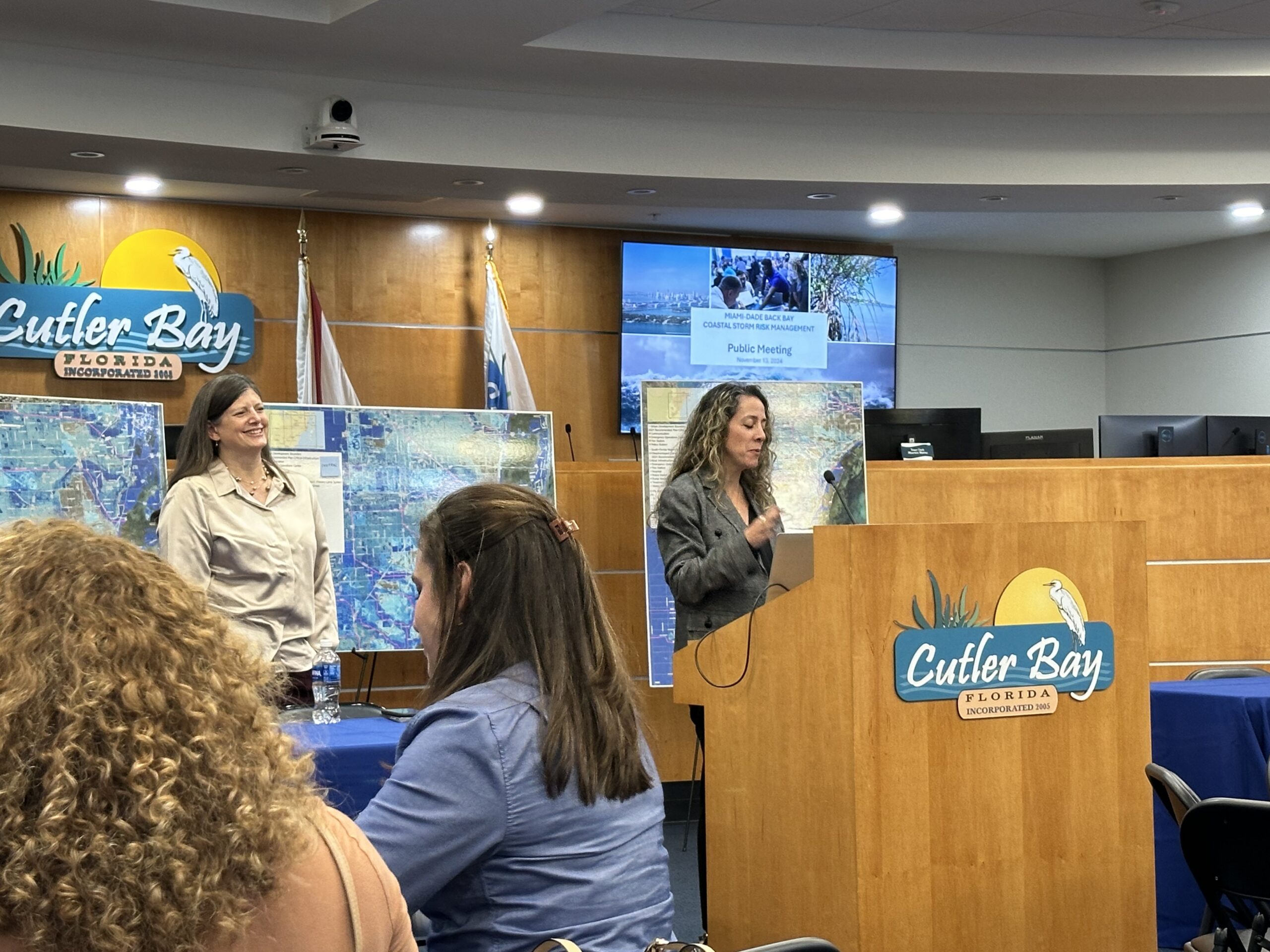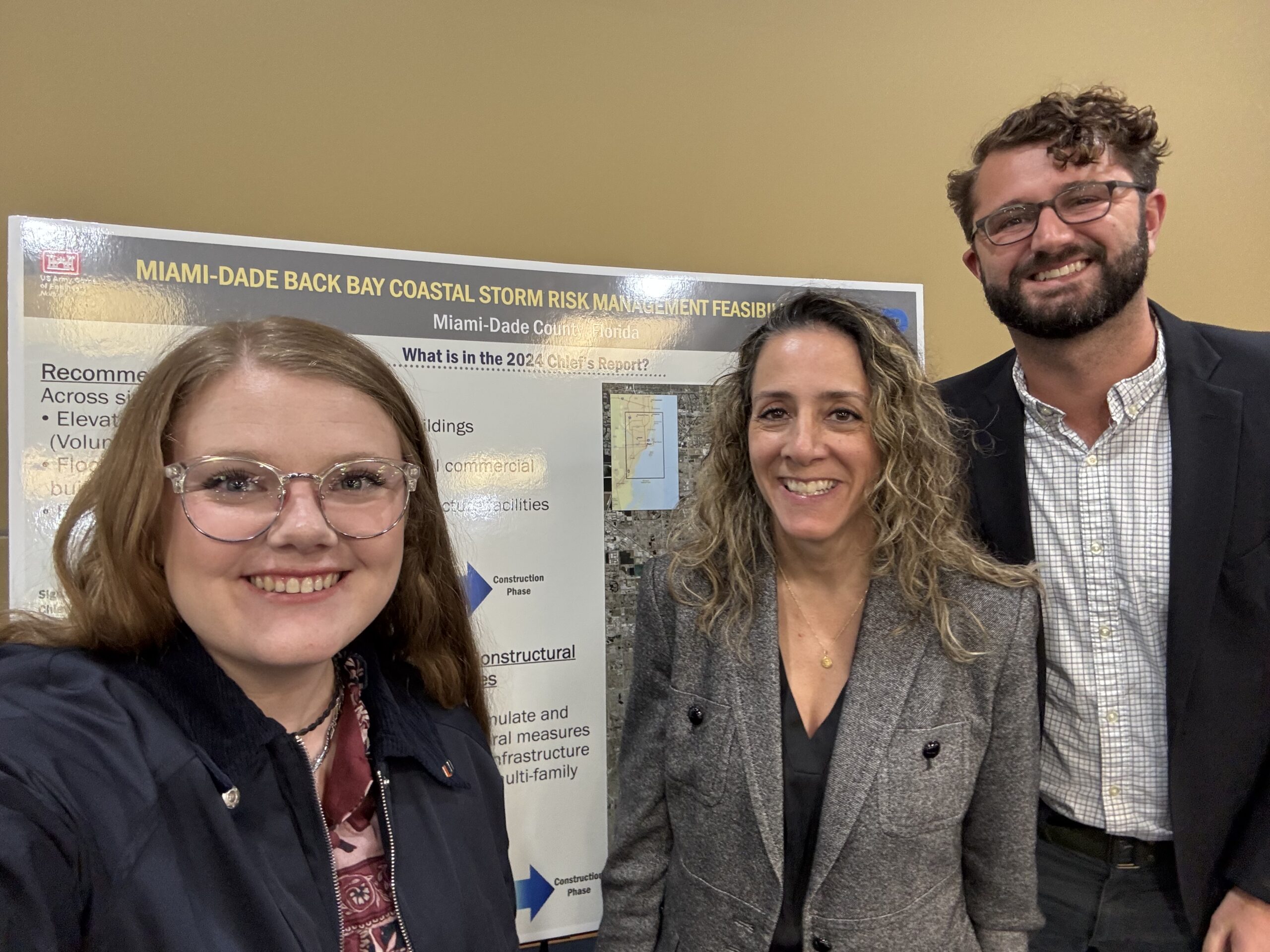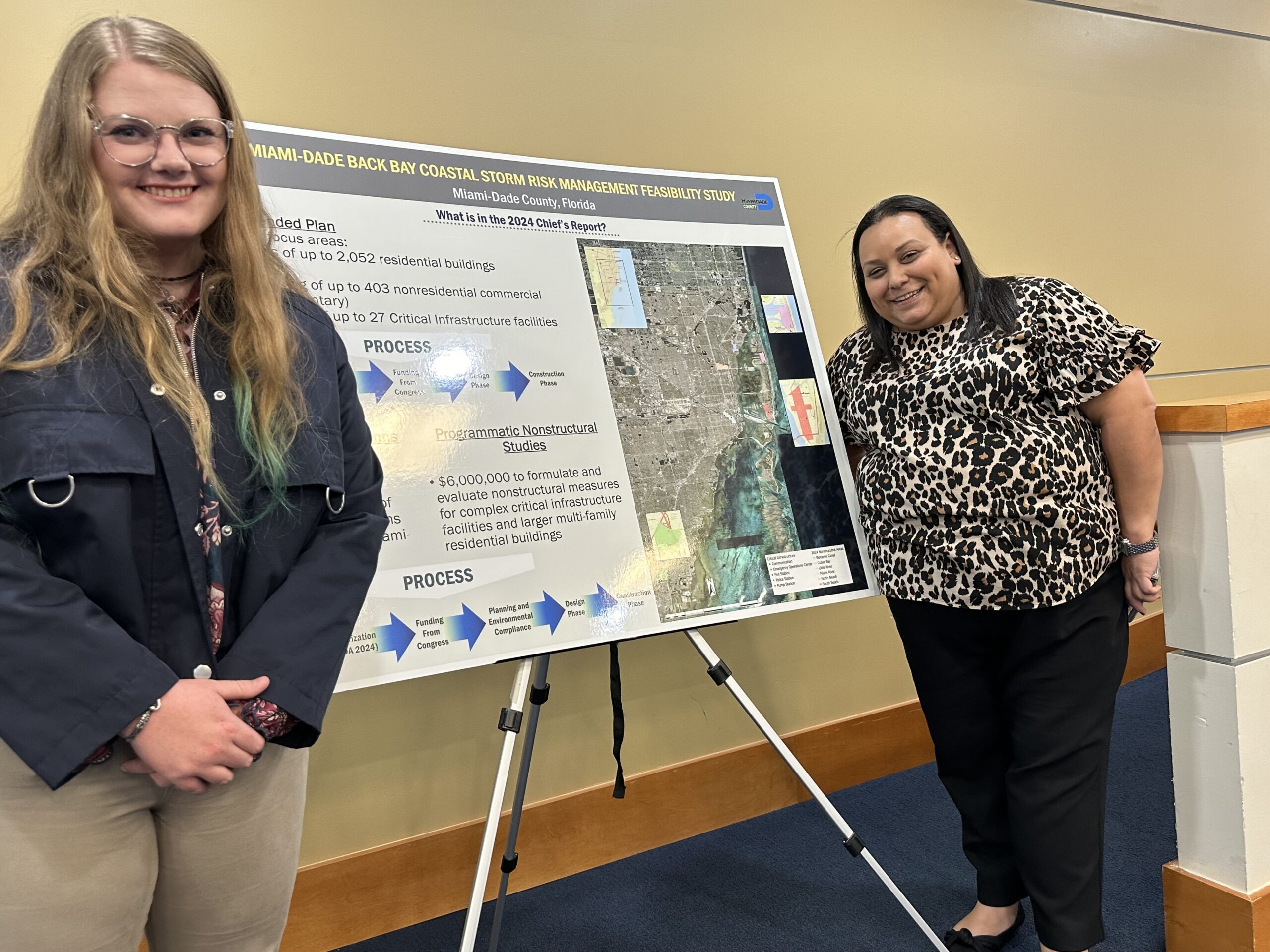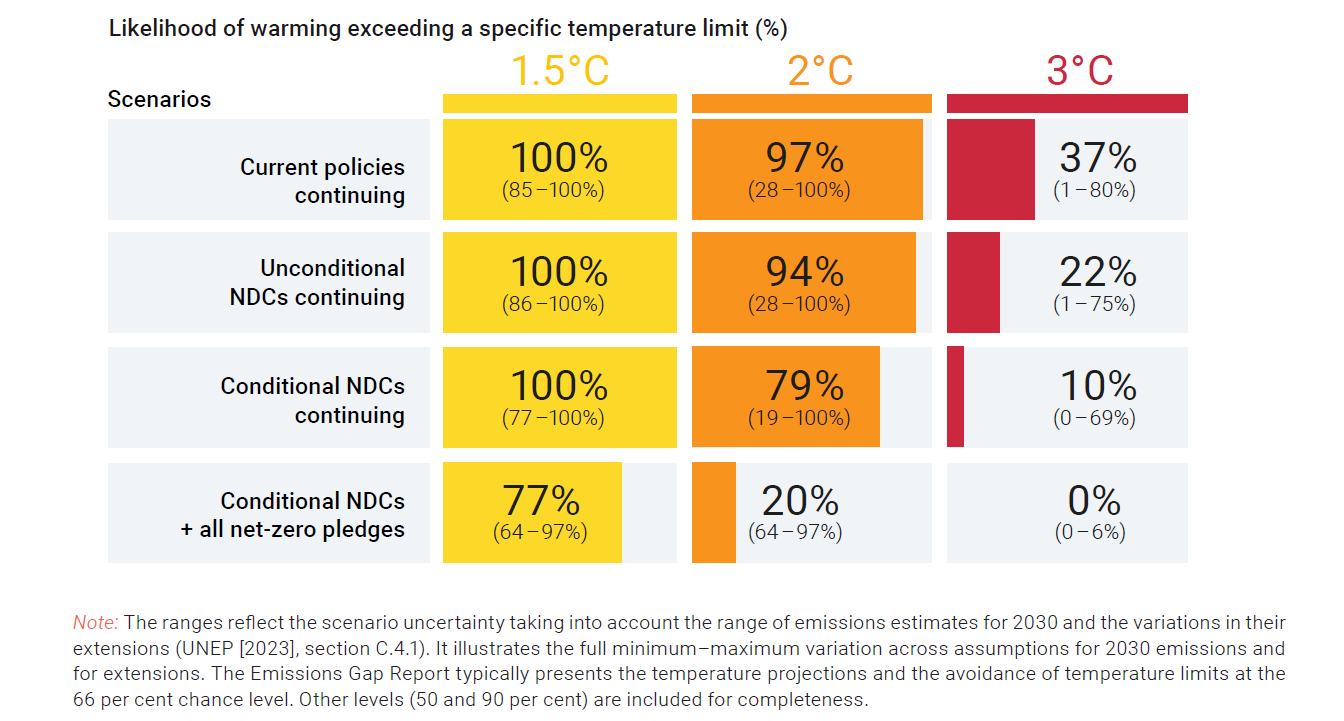
If our community ever has a chance at saving some of South Florida from rising seas and increasingly destructive storm surge caused by our climate crisis then maybe, just maybe, historians a hundred years from now will look back at the initial ground work comprised in what’s known as the Miami-Dade Back Bay Coastal Storm Risk Management (CSRM) Feasibility Study, or it’s more common name “the Back Bay Study.”
The importance of this initial work and how it will evolve in the decades to come is why I’ve been attending the various public planning meetings hosted by the federal government’s U.S. Army Corp of Engineers (USACE) Jacksonville, Florida and Norfolk, Virginia offices, along with Miami-Dade County’s Office of Resilience, including last Wednesday’s session held at the Town of Cutler Bay’s Town Hall in south Miami-Dade. The evening served as an in-person update on the status of the plan’s six pilot projects that the USACE is proposing be installed in and around Miami-Dade, including next steps as the plan seeks refinement before seeking Congressional approval much less seed money to fund the initial pilot programs. This week’s session in Cutler Bay followed the most recent significant step in the USACE process this last August when Lieutenant General Scott A. Spellmon, USACE Commanding General and 55th U.S. Army Chief of Engineers, signed what’s called the Chief’s Report for the Miami-Dade Back Bay Coastal Storm Risk Management Feasibility Study at USACE Headquarters in Washington, D.C.
The signing of the Report in August moved the $11.2 million federally funded study to the next phase of consideration for Congressional authorization and funding. The purpose of the study itself is to identify, evaluate, and recommend a set of prospective solutions for managing coastal storm surge risks to infrastructure, public health, and safety. The most recent iteration of the Chief’s Report recommends a nature-based solutions (NBS) pilot program and programmatic nonstructural studies for Congressional authorization which, together, are intended to help some of Miami-Dade County test a variety of solutions in hopes of protecting our region by reducing damage caused from future storm surge in a world where sea levels will be higher. I say “some of Miami-Dade” because the Village of Key Biscayne, the island community adjacent to the City of Miami that’s part of Miami-Dade County, is not included in the Back Bay Study but, instead, has a separate plan of its own.

Pilot Project Communities
The Back Bay Study is just that: a study. It is a test to try and learn what does and does not, perhaps, work. It is simply a pilot plan to experiment with a variety of storm surge resiliency steps, some manmade and others nature-based to learn whether they help. So to be clear, this is not a comprehensive solution but, I suppose, a start. Those six pilot projects will conceivably be expanded based on the initial test results and countless other factors. The six initial focus areas of the study include:
1. Biscayne Canal
2. Cutler Bay
3. Little River
4. Miami River
5. North Beach
6. South Beach

Sea Level Targets & Calculation Methodology
For their planning purposes the USACE is using a hydraulic model developed by the Hydrologic Engineering Center, called the River Analysis System (HEC-RAS). The HEC-RAS is used to develop a 50-year analysis of water surface profiles based on data from the USACE’s High Sea Level Curve projected out to 2095. The USACE calculates what’s called a 0.5% annual exceedance probability (AEP) stillwater evaluation from their South Atlantic Coastal Study (SACS), which is based on astronomical tide, storm surge, wave overtopping, and the USACE high sea level change scenario to the year 2095. Their process currently estimates seas could rise by about 4.5 feet and that target is what the initial plan takes into consideration.
Climate and Economic Justice Screening Tool (CEJST)
The magnitude of this problem and project is just immense. Beyond the planning, engineering, and physical work there are, for example, countless critical questions related to social vulnerability that must be answered such as what neighborhoods are vulnerable to storm surge and should be prioritized? Or what socioeconomic factors should help identify Environmental Justice communities? The USACE intends to use their Climate and Economic Justice Screening Tool (CEJST) to initially identify Environmental Justice Communities within Miami-Dade County.
You can find the Climate and Economic Justice Screening Tool here.

Summary of The 2024 Chief’s Report
Here’s a brief summary of the key current components that the 2024 Chief’s Report calls for:
1. A Nature Based Solutions Pilot Program estimated to cost about $180,000,000. Those funds, if/when approved, would be deployed throughout Miami-Dade in the initial six focus areas noted above. That money would then be used to identify, design, construct, and monitor a diverse mix of projects including mangrove installations, mosquito ditches, wetland restoration, human-made island enhancements, living shorelines, dune reinforcement, and hybrid coral reef structures as but a few examples.
2. A Programmatic Nonstructural Study that would cost about $6,000,000 is designed to create a plan to review nonstructural steps to protect complex critical infrastructure facilities (such as hospitals) and large multi-family residential buildings.
3. The Chief’s Report also includes a proposed hope for the voluntary elevation of up to 2,052 residential buildings within the six study areas. I suspect that folks all along Florida’s coast will one day face difficult decisions about whether to raise their homes or sell their property, perhaps through eminent domain type processes, as their access or use becomes impaired. For this reason I was curious about the USACE’s experience with having people raise their homes and during the public Q&A that followed this week’s meeting I asked them about it. I asked about the USACE’s experience having citizens raise their homes, how many homes have been raised in other areas as a result of their work, the process itself, and how all of this was received by people. The answer is a bit concerning in that they explained that, “only about 25 homes around the country have been raised. We have communities around different parts of the US in various planning stages where elevating structures will be part of the plan but as of today our experience is pretty limited.”
4. It is also hoped that floodproofing could take place on a voluntary basis in up to 403 nonresidential commercial buildings.
5. And there is also the hope that up to 27 critical infrastructure facilities can also be floodproofed.
As noted, the Miami-Dade Back Bay study is currently focused on six pilot areas within our county. When I asked, for example, about Key Biscayne the USACE explained that that island community is undergoing its own, separate, planning within their office. And when I asked about Monroe County, the USACE’s folks explained that some of their engineers had, in fact, been in the Florida Keys just this past week performing preliminary site visits but that the focus in that county, for now, was Hurricane Evacuation (meaning the required elevation of the road [US1] and bridges so as to allow folks to evacuate the island chain before a catastrophic hurricane were to arrive). None of these disconnected initial plans will, of course, make all of South Florida resilient to rising seas and to have any chance of saving as much of the region as possible the day will, in my view, soon need to come to have a combined, consolidated, and gosh knows unbelievably costly comprehensive plan, but for now we are nowhere near that sort of thinking today.
You can find the complete 2024 Chief’s Report here.

What’s next for the Back Bay Study?
What’s Next? Well, this is a long-term study and much of what happens will depend on what Congress says, does, and funds. As of today, the targeted near-term milestones include the following:
1. Alternative Milestone Meeting on January 17, 2025
2. Tentatively Selected Plan Meeting on February 26, 2026
3. Public Release of Draft Report on April 22, 2026
4. Agency Decision Milestone Meeting on August 20, 2026
5. Final Report Submittal on April 3, 2027
6. Signed Chief’s Report on August 2, 2027
Of course, all of those meetings and milestones depend on how the study process progresses and, ultimately, whether Congress decides to fund the Back Bay Study work any further and when. As I said, we are in the very initial stages of planning and all of this is understandably an incredibly complex long-term project that will progress in countless ways based on funding, what’s installed, how the pilot projects perform, how our society grapples with addressing the core causes of climate change (fossil fuel and greenhouse gas use), and how the scientific data and engineering evolve in the future.
For now, I’d encourage everyone to become involved in the discussion, attend future meetings, and to actively voice their ideas or concerns along the way. To learn more about the USACE Miami-Dade Back Bay Study you can visit here.







